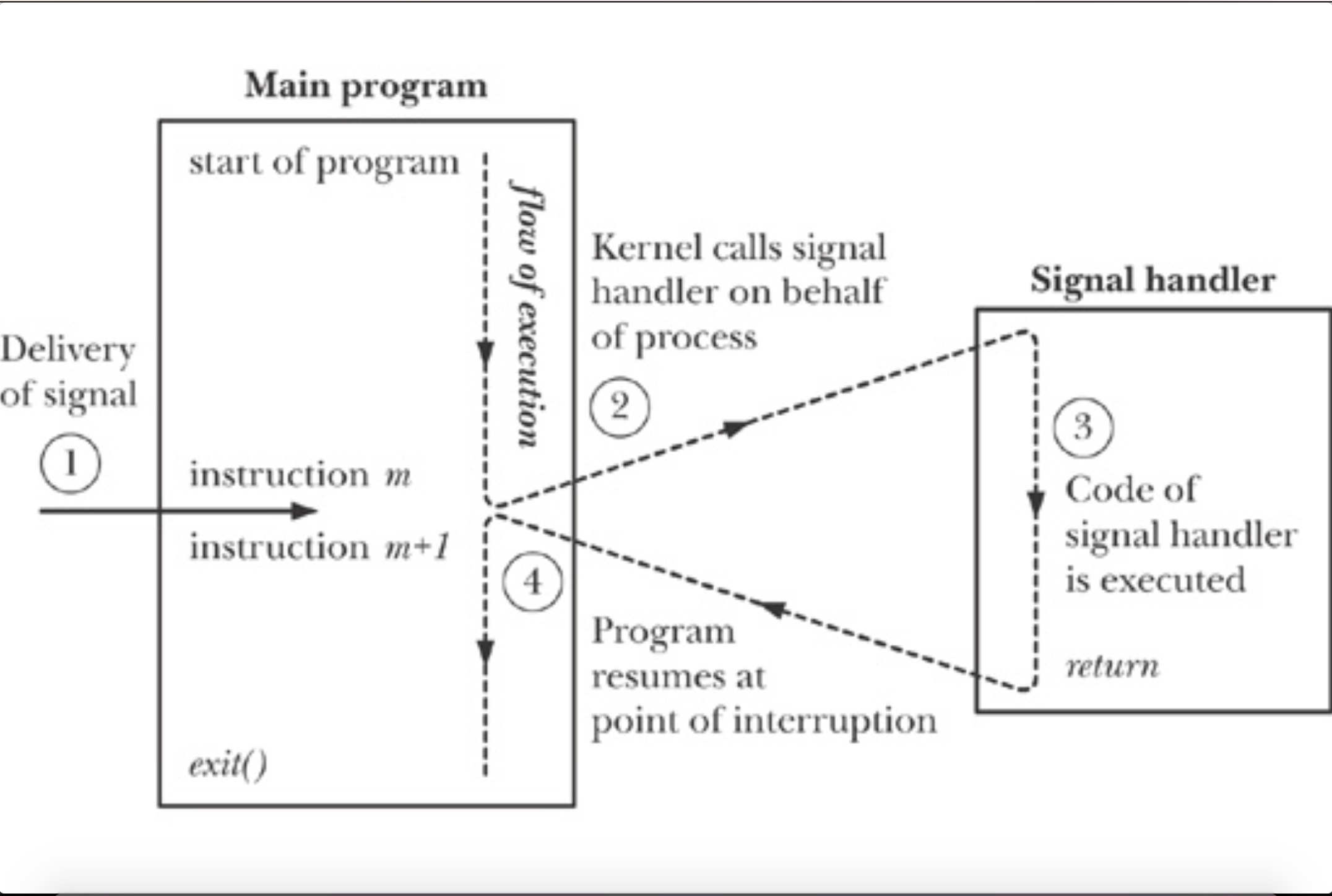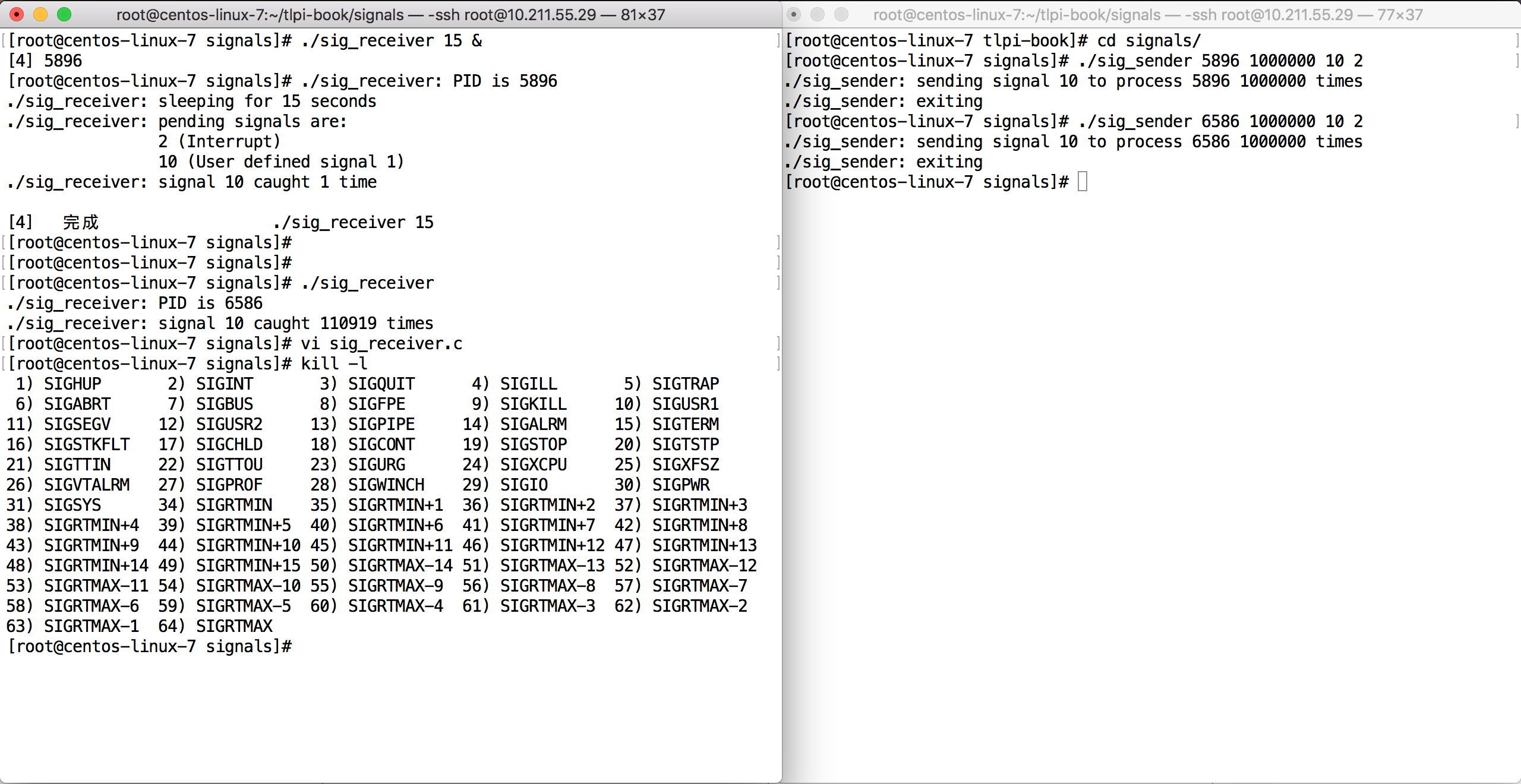整理书中的关于信号的例子,总结相关用法与误区。
信号是发生某种事件的通知机制,可以由内核、另一进程或进程自身发送给进程。存在一系列的标准信号类型,每种都有唯一的编号和目的。
信号传递通常是异步行为,这意味着信号中断进程执行的位置是不可预知的。默认情况下,要么忽略信号,要么终止进程,要么停止一个正在运行的进程。要么重启一个已停止的进程。特定的默认类型取决于信号类型。程序可以通过signal sigaction函数来显示忽略一个信号,或者建立一个由程序员自定义的信号处理器程序,以提供信号到达时调用。出于移植性考虑最好使用sigaction函数来建立信号处理函数。
一个具有相应权限的进程可以使用kill函数向另一进程发送信号。发送空信号是判定特定进程ID是否存在的方式之一。
每个进程都具有一个信号掩码,代表当前传递遭到阻塞的一组信号。使用sigprocmask()可以从信号掩码中添加或者移除信号。
如果接收的信号当前遭到阻塞,那么该信号将保持等待状态,直到解除对其阻塞。系统不会对标准信号进行排队处理,即将信号标记为等待(以及后续的传递)只会发生一次,进程使用sigpending系统调用来获取等待信号集(用以描述多个不同信号的数据结构)。
与signal相比,signaction系统调用在设置信号处置方面提供了更多控制,且更具灵活性。借助于pause()进程可以暂停执行,直到信号到达为止。
信号到达并执行处理器程序过程:
上图中1是信号到达
2是内核代表进程调用信号处理函数
3是执行信号处理函数
4是程序从中断点恢复执行
/*************************************************************************\
* Copyright (C) Michael Kerrisk, 2017. *
* *
* This program is free software. You may use, modify, and redistribute it *
* under the terms of the GNU General Public License as published by the *
* Free Software Foundation, either version 3 or (at your option) any *
* later version. This program is distributed without any warranty. See *
* the file COPYING.gpl-v3 for details. *
\*************************************************************************/
/* Listing 20-1 */
#include <signal.h>
#include <stdio.h>
#include <errno.h>
static void
sigHandler(int sig)
{
printf("Ouch!\n"); /* UNSAFE (see Section 21.1.2) */
}
int
main(int argc, char *argv[])
{
int j;
if (signal(SIGINT, sigHandler) == SIG_ERR)
perror("signal");
for (j = 0; ; j++) {
printf("%d\n", j);
sleep(3); /* Loop slowly... */
}
}
/*************************************************************************\
* Copyright (C) Michael Kerrisk, 2017. *
* *
* This program is free software. You may use, modify, and redistribute it *
* under the terms of the GNU General Public License as published by the *
* Free Software Foundation, either version 3 or (at your option) any *
* later version. This program is distributed without any warranty. See *
* the file COPYING.gpl-v3 for details. *
\*************************************************************************/
/* Listing 20-2 */
#include <signal.h>
#include <stdio.h>
#include <errno.h>
#include <stdlib.h>
static void
sigHandler(int sig)
{
static int count = 0;
/* UNSAFE: This handler uses non-async-signal-safe functions
(printf(), exit(); see Section 21.1.2) */
if (sig == SIGINT) {
count++;
printf("Caught SIGINT (%d)\n", count);
return; /* Resume execution at point of interruption */
}
/* Must be SIGQUIT - print a message and terminate the process */
printf("Caught SIGQUIT - that's all folks!\n");
exit(EXIT_SUCCESS);
}
int
main(int argc, char *argv[])
{
/* Establish same handler for SIGINT and SIGQUIT */
if (signal(SIGINT, sigHandler) == SIG_ERR)
perror("signal");
if (signal(SIGQUIT, sigHandler) == SIG_ERR)
perror("signal");
for (;;) /* Loop forever, waiting for signals */
pause(); /* Block until a signal is caught */
}
上面的程序相对简单,是signal的基础使用范例,需要注意的是上面的程序在signal信号处理程序中使用了printf()函数来显示消息。实际工程项目中不会在信号处理程序中使用stdio函数,范例使用stdio函数为了清除观察信号处理函数的调用与执行。
/*************************************************************************\
* Copyright (C) Michael Kerrisk, 2017. *
* *
* This program is free software. You may use, modify, and redistribute it *
* under the terms of the GNU General Public License as published by the *
* Free Software Foundation, either version 3 or (at your option) any *
* later version. This program is distributed without any warranty. See *
* the file COPYING.gpl-v3 for details. *
\*************************************************************************/
/* Listing 20-3 */
#include <signal.h>
#include "tlpi_hdr.h"
int
main(int argc, char *argv[])
{
int s, sig;
if (argc != 3 || strcmp(argv[1], "--help") == 0)
usageErr("%s pid sig-num\n", argv[0]);
sig = getInt(argv[2], 0, "sig-num");
s = kill(getLong(argv[1], 0, "pid"), sig);
if (sig != 0) {
if (s == -1)
errExit("kill");
} else { /* Null signal: process existence check */
if (s == 0) {
printf("Process exists and we can send it a signal\n");
} else {
if (errno == EPERM)
printf("Process exists, but we don't have "
"permission to send it a signal\n");
else if (errno == ESRCH)
printf("Process does not exist\n");
else
errExit("kill");
}
}
exit(EXIT_SUCCESS);
}
下面重点记录下面的一个例子:
/*************************************************************************\
* Copyright (C) Michael Kerrisk, 2015. *
* *
* This program is free software. You may use, modify, and redistribute it *
* under the terms of the GNU General Public License as published by the *
* Free Software Foundation, either version 3 or (at your option) any *
* later version. This program is distributed without any warranty. See *
* the file COPYING.gpl-v3 for details. *
\*************************************************************************/
/* Listing 20-6 */
/* sig_sender.c
Usage: sig_sender PID num-sigs sig [sig2]
Send signals to sig_receiver.c.
Sends 'num-sigs' signals of type 'sig' to the process with the specified PID.
If a fourth command-line argument is supplied, send one instance of that
signal, after sending the previous signals.
*/
#include <signal.h>
#include "tlpi_hdr.h"
int
main(int argc, char *argv[])
{
int numSigs, sig, j;
pid_t pid;
if (argc < 4 || strcmp(argv[1], "--help") == 0)
usageErr("%s pid num-sigs sig-num [sig-num-2]\n", argv[0]);
pid = getLong(argv[1], 0, "PID");
numSigs = getInt(argv[2], GN_GT_0, "num-sigs");
sig = getInt(argv[3], 0, "sig-num");
/* Send signals to receiver */
printf("%s: sending signal %d to process %ld %d times\n",
argv[0], sig, (long) pid, numSigs);
for (j = 0; j < numSigs; j++)
if (kill(pid, sig) == -1)
errExit("kill");
/* If a fourth command-line argument was specified, send that signal */
if (argc > 4)
if (kill(pid, getInt(argv[4], 0, "sig-num-2")) == -1)
errExit("kill");
printf("%s: exiting\n", argv[0]);
exit(EXIT_SUCCESS);
}
/*************************************************************************\
* Copyright (C) Michael Kerrisk, 2015. *
* *
* This program is free software. You may use, modify, and redistribute it *
* under the terms of the GNU General Public License as published by the *
* Free Software Foundation, either version 3 or (at your option) any *
* later version. This program is distributed without any warranty. See *
* the file COPYING.gpl-v3 for details. *
\*************************************************************************/
/* Listing 20-7 */
/* sig_receiver.c
Usage: sig_receiver [block-time]
Catch and report statistics on signals sent by sig_sender.c.
Note that although we use signal() to establish the signal handler in this
program, the use of sigaction() is always preferable for this task.
*/
#define _GNU_SOURCE
#include <signal.h>
#include "signal_functions.h" /* Declaration of printSigset() */
#include "tlpi_hdr.h"
static int sigCnt[NSIG]; /* Counts deliveries of each signal */
static volatile sig_atomic_t gotSigint = 0;
/* Set nonzero if SIGINT is delivered */
static void
handler(int sig)
{
if (sig == SIGINT)
gotSigint = 1;
else
sigCnt[sig]++;
}
int
main(int argc, char *argv[])
{
int n, numSecs;
sigset_t pendingMask, blockingMask, emptyMask;
printf("%s: PID is %ld\n", argv[0], (long) getpid());
/* Here we use the simpler signal() API to establish a signal handler,
but for the reasons described in Section 22.7 of TLPI, sigaction()
is the (strongly) preferred API for this task. */
for (n = 1; n < NSIG; n++) /* Same handler for all signals */
(void) signal(n, handler); /* Ignore errors */
/* If a sleep time was specified, temporarily block all signals,
sleep (while another process sends us signals), and then
display the mask of pending signals and unblock all signals */
if (argc > 1) {
numSecs = getInt(argv[1], GN_GT_0, NULL);
sigfillset(&blockingMask);
if (sigprocmask(SIG_SETMASK, &blockingMask, NULL) == -1)
errExit("sigprocmask");
printf("%s: sleeping for %d seconds\n", argv[0], numSecs);
sleep(numSecs);
if (sigpending(&pendingMask) == -1)
errExit("sigpending");
printf("%s: pending signals are: \n", argv[0]);
printSigset(stdout, "\t\t", &pendingMask);
sigemptyset(&emptyMask); /* Unblock all signals */
if (sigprocmask(SIG_SETMASK, &emptyMask, NULL) == -1)
errExit("sigprocmask");
}
while (!gotSigint) /* Loop until SIGINT caught */
continue;
for (n = 1; n < NSIG; n++) /* Display number of signals received */
if (sigCnt[n] != 0)
printf("%s: signal %d caught %d time%s\n", argv[0], n,
sigCnt[n], (sigCnt[n] == 1) ? "" : "s");
exit(EXIT_SUCCESS);
}
上述程序来展示的是遭阻塞的信号无论产生了多少次,仅会传递一次,这里为接收者指定了一个睡眠间隔,并在醒来之前发送所有信号。执行时我们指定SIGUSR1和SIGINT信号,其在Linux/x86中的编号分别为10和2。由第一次执行结果可知,即使一个信号发送了一百万次,在设置阻塞后仅会传递一次给接收者。
第二次执行时进程没有阻塞信号,其所接收到的信号也比发送的信号少的多,原因在于发送程序会在每次获得调度而运行时发送多个信号给接收者。然而,当接收进程得以运行时,传递来的信号只有一个,因为只会将这些信号中的一个标记为等待。

